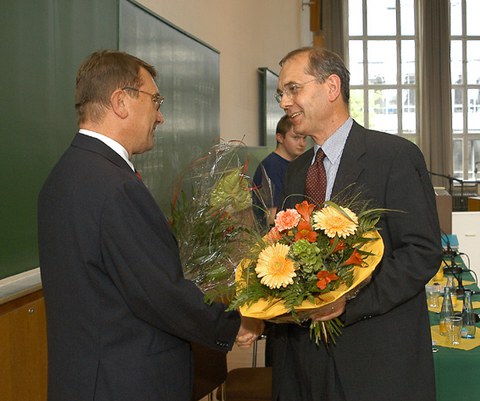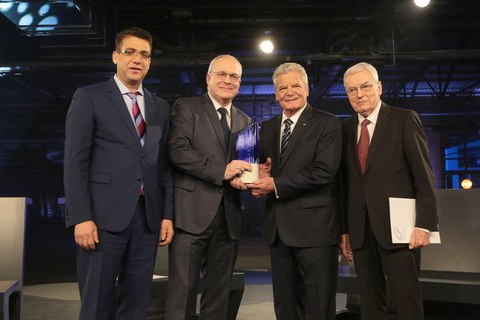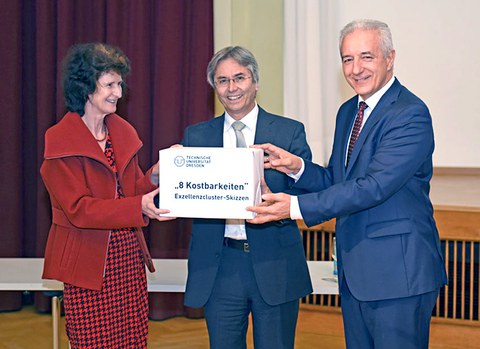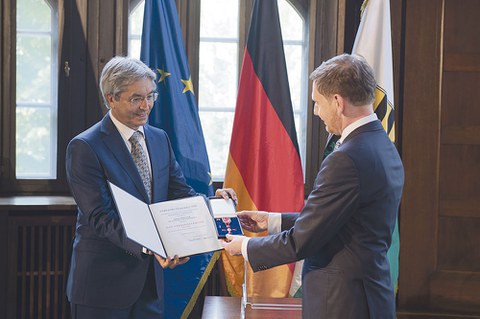21st Century
Table of contents
From 2000 to 2009
2000

Medical Theory Centre (MTZ)
On 31 May, the Medical Theory Centre (MTZ) at the TU Dresden will be handed over. The MTZ includes seven institutes of pre-clinical research and clinical theory, the Experimental Centre of the Faculty of Medicine and approximately 3.000 square metres for research purposes. Additionally available are two lecture halls, classrooms for practical work and eight seminar rooms with a total capacity of approximately 700 seats.

Nobel Prize winner Günter Blobel becomes Honorary Senator of the TU Dresden
On 19 June 2000 Nobel prize winner Professor Günter Blobel, MD/PhD (Rockefeller University, Laboratory of Cell Biology, New York) will be appointed honorary senator of the TU Dresden. With this appointment the university not only expresses its appreciation of the Nobel prize winner. Over and above that, Mr. Blobel, as an honorary senator, will contribute his expert knowledge from his work in research and science to act as an advisor to the Senate of TU Dresden.
2001
On 14 March the regulations for the the management and the operation of the Biotechnological Centre of the TU Dresden (BIOTEC) will be adopted by the Senate. BIOTEC is a centrally located scientific institution aiming at using the rapidly developing rate of knowledge in modern biology and biochemistry in medicine, technology, and nutritional development.

New building of the Chemical Institutes
On 16 October the first part of the new building of the Chemical Institute at TU Dresden will be handed over. This building offers excellent working conditions for the almost 200 employees of the Institute of Organic Chemistry, Food - and Biochemistry as well as Analytical Chemistry.
2002
On 16 April the Max-Bergmann-Centre for Biomaterials will be inaugurated. The new research building was established in co-operation with TU Dresden and the Institute of Polymere Research (IPF). The scientific policy of the centre has the goal to become a structural model for close co-opration between universities and institutions of the Scientific Asociation "Gottfried Wilhelm Leibnitz".
For the first time in the history of the university there are more than
30.000 students enrolled, among them 8.5 percent international.
2003

SLUB Dresden
On 14 January the new Saxon State and University Library (SLUB) will open in Zellescher Weg. With its almost 30.000 square metres of principal utilisable space, six million media units and 990 seats in reading rooms, it is the fourth-largest and most modern library in Germany.
In 2003, the TU9 Alliance is founded as an informal group of rectors and presidents and TU Dresden is a member. On 26th January 2006, the nine member universities merge to form a formal alliance. Since then, TU Dresden has belonged to this group of Germany’s leading technical universities.

Festival week 175 years TU Dresden
In May, TU Dresden celebrates its 175th anniversary with a week of festivities. Solely for this occasion Professor Wilfried Krätzschmar has composed a symphony, which will be performed at the "Große Haus" Theatre on 3 May. Further highlights are the first exhibition of "Fascination: Art + Technology" in the new ALTANA-Gallery at the renovated Görges-Bau and the performance of the play "Alma: Journey Through Time" by Walther Henkel performed by students and staff members during the ceremony on 6 May.

Rector election 2003: Prof. Achim Mehlhorn (l.) and Prof. Hermann Kokenge (r.)
On 9 July Professor Hermann Kokenge will be elected new Rector of TU Dresden. He will succeed Prof. Dr. Achim Mehlhorn, who had held the position for three terms of office.
On 10 July the Saxon Prime Minister, Georg Mibradt, will sign the University Contract. With this, the universities in Saxony shall receive personnel and financial planning security until 2010. This contract, also called "university consense", means for TU Dresden that, among other things, the Faculty of Law will be transferred to Leipzig. Simultaneously, the courses of studies for civil engineering students as well as the students of trade and commerce will be concentrated on Dresden. The contract negotiations had been accompanied by students´ protests.
On 22 October the foundation-stone was laid for the new building of the Department of Computer Science.
2004
Work started on the renovation of the TU Dresden building complex in Mommsenstraße – the former office of the rectorial board / the central administration / the old dining halls Alte Mensa.
In March 2004, a topping-out ceremony marks the completion of the new buildings for the TU Dresden biology institutes on Zellescher Weg.

Children´s University
May 2004 sees the official start of the Children’s University with more than 1,000 children registering for the lecture programme.
In November 2004, a topping-out ceremony is held to celebrate the completion of the new building for the department of computer science in Nöthnitzer Straße.
Chipmakers AMD and Infineon in co-operation with Fraunhofer Society open the Fraunhofer Center Nanoelectronic Technologies (CNT).
2005
On 1 July 2005, the nuclear training reactor AKR-2 is commissioned by the TU Dresden scientific community. The new construction of the AKR-2 allows academics and students of TU Dresden to work at the most modern nuclear training reactor in Germany.
On 9 September 2005, ground is officially broken for the Diagnostic-Internal-Neurological Centre (DINZ) at the University Hospital Carl Gustav Carus Dresden.
2006
In January 2006, the former rector of TU Dresden, Professor Achim Mehlhorn, becomes president of the further education institution Dresden International University (DIU).
TUD is the only university in East Germany that was granted funding both of a graduate school (Dresden International Graduate School for Biomedicine and Bioengineering) and an excellence cluster (From Cells to Tissues to Therapies) in the first round of the excellence initiative for promoting top-class university research.

New building of the Faculty of Computer Science
In October 2006, the new building of the Faculty of Computer Science in Nöthnitzer Straße is inaugurated; in 2014 it is named Andreas Pfitzmann building.

New building of the Biological Institutes
And also the new buildings for the biological institutes (Zellescher Weg) are brought into service.
On 1 November 2006, the rector’s post is filled for the term 2006 to 2009 after three ballots. The outgoing holder, Professor Hermann Kokenge, got the most votes in the third ballot.
2007
In July, the administration building in Mommsenstraße is reopened after several years of renovation.
At the same time, extensive renovation and the new addition to the dining hall complex Mensa Mommsenstraße are completed.

University with child
Moreover this is the year that TU Dresden receives the basic certificate of the audit ‘family-friendly university’. Along with the Saxon State Ministry of Science and Art and the Leibniz Institute for Solid State and Materials Research TU Dresden forms the core of the Dresden network Dresdner Netzwerk berufundfamilie (Dresden Network Career and Family) that is joined by further institutions.
2008
On 17 July 2008, the topping-out ceremony for the second section of the new addition to the chemical institutes is held.

Student Demonstration 2008
Late in autumn, students from allover Saxony come to Dresden to protest against the amendment of the Law on Higher Education in the Free State of Saxony.
2009
In January 2009 the TU Dresden teamed up with 14 strong partners from the world of science and culture to establish a unique, country-wide Alliance “DRESDEN-concept” (Dresden Research and Education Synergies for the Development of Excellence and Novelty). The goal is to increase the visibility of the Dresden research excellence.

Student Demonstration 2009
In June, students once again took to the streets with the “Education Strike” action.

Trefftz-Bau
On 14th October 2009, the extensively renovated and modernised “Trefftz-Bau” was reinaugurated.
From 2010 to today
2010
The first part of the construction project of the Diagnostic Internistic Neurological Centre (DINZ) is completed. The “SIB – Staatsbetrieb Sächsiches Immobilien- und Baumanagement” (Saxonian, state-owned Real Estate and Construction Management company) hands over the extended “House 48” to the university hospital.

Investiture 2010
In June 2010, the extended Senate of the TU Dresden elected Prof. Dr. Dr.-Ing. Habil. Hans Müller-Steinhagen as rector for a five-year term of office. Prior to that, Prof. Müller-Steinhagen was the Director of the Institute of Technical Thermodynamics at the German Aerospace Center (DLR) as well as Professor and Director of the University of Stuttgart’s Institute for Thermodynamics and Thermal Engineering.
In September 2012, the TU Dresden submits a comprehensive application package for the “Excellence Initiative” launched by the German state and federal government. The aim of the Excellence Initiative is to promote top-level research and to improve the quality of Germany as a university and science location, as well as to sustainably strengthen it.
In 2010, The Student Foundation Dresden has been selected as a “Hochschulperle” by the “Stifterverband” (an initiative by companies and foundations, which strives to consult, link and promote in the areas of education, science and innovation).
The “Stifterverband” honours small, innovative university projects every month and determines the annual winner by an online vote. The “Hochschulperle” aims to enhance the public visibility of exemplary projects.
In October 2010, 7.900 new students started their studies at the TU Dresden. In total, 36.000 students are enrolled at the TU Dresden.
2011

Event on the Excellence Initiative
On 2rd March, the “Deutsche Forschungsgemeinschaft” (DFG, German Research Foundation) and the “Wissenschaftsrat” (German Council of Science and Humanities) decided that the TU Dresden has cleared the first hurdle of the excellence competition and is now permitted to submit the complete application package for its Institutional Strategy as well as for the Cluster of Excellence (cfaed – Center of Advancing Electronics Dresden).
Professor Karl Leo, Head of the Institute of Applied Physics and Professor for Opto-Electronics at TU Dresden, is awarded the German Future Award together with Dr Jan Blochwitz-Nimoth (Novaled AG) and Dr Martin Pfeiffer (Heliatek GmbH). This prize honours their cutting-edge research work in the field of organic light-emitting diodes (OLEDs). Already in 2002, Professor Leo had received the Gottfried Wilhelm Leibniz Prize.
2012
With the introduction of an SAP system at TU Dresden in January 2012, the IT landscape undergoes a fundamental transformation towards a highly integrated IT application.
In February 2012, the Welcome Center for international guest scientists is established at TU Dresden.

Done, the TU Dresden is a university of excellence! TUD Rector Prof. Hans Müller-Steinhagen announces the positive decision
On 15th June 2012, the TU Dresden has been awarded the title of “University of Excellence” as part of the Excellence Initiative Programme launched by the German federal and state governments, for its Institutional Strategy, the Cluster of Excellence “cfaed – Center for Advancing Electronics Dresden” and the two renewal proposals from the first application round.
2013
On 1 January 2013, the International Institute (IHI) Zittau is integrated into TU Dresden by decision of the Saxon Landtag. At that time, approximately 200 German and 100 international students are studying at IHI Zittau.
For the first time worldwide, a patient with type 1 diabetes is implanted an artificial pancreas system at the Dresden University Hospital (Prof. Stefan Bornstein, Dr Barbara Ludwig). The operation is considered a milestone in medicine.
With the symbolic activation of the proton accelerator (cyclotron) on 17 September 2013, Federal Minister of Education and Research, Prof. Johanna Wanka, and Saxon Prime Minister Stanislaw Tillich, inaugurate the new domicile of the "National Center for Radiation Research in Oncology - OncoRay" on the Dresden campus of University Medicine. About 150 doctors and scientists are to work on radiation therapy of the future in the new building, which is completed ahead of schedule. Supporting institutions of "OncoRay" are the University Hospital Carl Gustav Carus, the eponymous TU Dresden Faculty of Medicine and the Helmholtz Zentrum Dresden-Rossendorf (HZDR). In the worldwide unique research and development platform, the use of protons for careful cancer therapy is being further developed in a patient-friendly way beyond commercial obligations in the coming years.

Werner-Hartmann-Bau
On 2 December 2013, the Werner Hartmann building in Nöthnitzer Straße is inaugurated after a two-year construction period. The Technical Centre is a facility for research works in micro- and nano-electronics and belongs to the Faculty of Electrical and Computer Engineering.
In November, the first Diversity Days take place at TU Dresden. The focus is on the variety of cultures at the university.
2015

Prof. Hans-Ulrich Wittchen, Prof. Hans Müller-Steinhagen and Prof. Klaus Raps (from left to right)
On 13 May 2015, the TU Dresden Senate re-elects Prof. Hans Müller-Steinhagen Rector of TU Dresden for the term 2015-2020. The first ones to congratulate are Election Supervisor Prof. Hans-Ulrich Wittchen and Prof. Klaus Raps, Deputy Chairman of the TU Dresden University Council.

Stanislaw Tillich (Minister President of the Free State of Saxony), Prof. Johanna Wanka (Federal Minister of Education and Research), Prof. Hans Müller-Steinhagen (TUD Rector) and Prof. Wolfgang E. Nagel (Director of ZIH; from left to right)
On 13 May 2015, the new high-performance computer HRSK II is put into operation and the Lehmann Computing Centre, which is designed according to the latest standards, is opened. The new supercomputer with approximately 43,000 CPU cores and a peak performance of over 1.5 quadrillion operations per second replaces the HPC systems, which had so far been used at the TU Dresden Centre for Information Services and High Performance Computing (ZIH). The new computing centre is characterised by energy efficiency, and thus cost efficiency. The hot water cooling of the HRSK-II alone saves more than EUR 250,000 of operating expenses per year through the renouncement of refrigerating machines. Additional savings arise from the subsequent use of computer waste heat in surrounding buildings.
As of 4 August 2015, the TUD sports facilities at Nöthnitzer Straße are being vacated. Starting from September 2015 until mid-May, they are used as a first reception facility for refugees.
In the ranking of the German Research Foundation, TU Dresden ranks among the top ten for the first time.
2016
The German Aerospace Center (DLR) has decided to set up a software institute in Dresden. It is to be embedded in the Lehmann Centre, a central scientific institution of TU Dresden. The aim of the new Dresden institute is the strategic platform research and development in order to support the virtual system ability of the German aviation sector in the areas of hardware, software and application systems. Emphasis is put on research for innovative technologies during the application-related implementation in the fields of production engineering and robotics, systems and simulation as well as virtual reality.

Prof. Chokri Cherif, Prof. Manfred Curbach, Federal President Jochim Gauck and Prof. Peter Offermann (from left to right)
On 30 November 2016, TUD professors Manfred Curbach, Chokri Cherif and Peter Offermann win the German Future Award endowed with EUR 250,000. The three researchers developed the new composite material carbon concrete, containing carbon as reinforcement instead of steel.
On 19 December 2016, the State Government of Saxony and the 14 state universities sign a grant agreement. Thus, a stable foundation and an unusually long-term financing framework for Saxon universities until the end of 2024 are created. For universities, the grant agreement with a total volume of over EUR 6.5 billion is a reliable basis for financial planning security, and it increases their resources as well as their scopes for action. This ensures, among other things, the financing of 9,034 staff positions at the universities. In addition, the renouncement of the planned cutback of 754 posts from 2017 on is agreed upon.
2017

Hermann-Krone-Bau
On 23rd January 2017, the new building of the Institute of Applied Physics was inaugurated. It will be known as the “Hermann-Krone-Bau”. Researchers from the Dresden Integrated Center for Applied Physics and Photonic Materials (IAPP) and the Center for Advancing Electronics Dresden (cfaed) will move into the new 29.45 million Euro building.

Dr. Eva-Maria Stange, Prof. Hans Müller-Steinhagen and Stanislaw Tillich (from left to right)
On 3 April 2017, .Rector Prof Hans Müller-Steinhagen has launched TUD’s new application for the Federal and State Excellence Strategy by handing over eight draft proposals in the “Clusters of Excellence” funding line to Saxon Prime Minister Stanislaw Tillich (on the right) and to Saxon State Minister for Science and the Arts, Dr Eva-Maria Stange (on the left)
As of 1 October 2017, the existing departments of the School of Science, namely Biology, Chemistry and Food Chemistry, Mathematics, Physics and Psychology, are converted into faculties. TU Dresden now has a total of 18 faculties.
2018
On 27th September 2018, the German Research Foundation (DFG) approved three of a total of six Clusters of Excellence within the framework of the Excellence Strategy of the federal and state government. TU Dresden thus remains in the competition for the University of Excellence title.
The following clusters were approved:
- PoL: Physics of Life (Prof. Stephan Grill)
- CeTI: Centre for Tactile Internet (Prof. Frank Fitzek)
- ct.qmat: Complexity and Topology in Quantum Materials (Prof. Matthias Vojta)
The new Clusters of Excellence will be funded from 1st January 2019 for a period of seven years.

The new building of the DZNE and (ZIK) B CUBE
On 16th November 2018, Saxony's Minister of Finance, Dr. Matthias Haß, handed over the keys for the new building of the German Center for Neurodegenerative Diseases (DZNE) and the B CUBE Center for Innovation Competence (ZIK) to the Chairman of the DZNE board, Prof. Pierluigi Nicotera, and the Rector of TU Dresden, Prof. Hans Müller-Steinhagen. The construction began in October 2015 with costs amounting to approximately 42 million euro.

Heinz-Schönfeld-Hörsaal at Barkhausen-Bau
On 23rd November 2018, the renovated Heinz-Schönfeld lecture hall was handed over to TUD. With its 481 seats, it is one of the largest lecture halls of TU Dresden. Construction began in March 2016 with costs totalling 8 million euro. The auditorium building forms the southernmost part of the Barkhausen building complex.
In November, TU Dresden was successful in the DFG funding decision for Collaborative Research Centres (CRC). The establishment of the CRC/TR 248 "Fundamentals of Comprehensible Software Systems" in the field of computer science and the continuation of the CRC 1143 "Correlated Magnetism: From Frustration to Topology" in the field of solid state physics were approved.
In time for the deadline of 10th December 2018, TU Dresden submitted its application for the University of Excellence title to the German Council of Science and Humanities in Cologne. At the same time, the "OUR UNI" campaign was launched, which will accompany the application phase up to the decision on 19th July 2019.
2019
The German Research Foundation (DFG) has announced that it will fund three Collaborative Research Centres (CRCs) at TU Dresden. New CRCs will be established in the fields of joining technology as well as in medicine. In addition, the CRC on the thermo-energetic design of machine tools was granted renewed funding after re-applying. This brings the total number of CRCs at TU Dresden to 13.

The TU Dresden remains a university of excellence. Rector Prof. Hans Müller-Steinhagen is delighted
The German Council of Science and Humanities announced on 19th July that TU Dresden will receive permanent funding as a University of Excellence. TU Dresden is one of a total of 11 Universities of Excellence in Germany and the only University of Excellence in the eastern German federal states (except Berlin).
2020

Prof. Ursula M. Staudinger
On 17th March, TU Dresden’s Extended Senate elected psychologist Prof. Ursula M. Staudinger to be the new Rector for a five-year term of office. In TUD's history, she is only the second woman to hold the position of Rector after the nuclear physicist Lieselott Herforth. Professor Staudinger is an internationally renowned researcher on ageing. From 1999 to 2003, she was a professor at TU Dresden. At the time of her election, she holds a lifetime professorship in socio-medical sciences at the Columbia Aging Center at Columbia University in New York, which she founded in 2013. On 18th August, she assumed the official duties as Rector, her ceremonial inauguration took place on 21st September.
In spring of 2020, the coronavirus pandemic reached Germany. On 21st March, several weeks of TUD operating in emergency mode began. Teaching, research and administration buildings could only be entered with an exemption permit. The SLUB library closed. From 6th April, the on-site teaching of the summer semester was replaced by virtual lectures. More than 80 percent of the courses offered were converted to online formats. Most TUD employees were working remotely. On 20th April, limited laboratory-based research was resumed. To a limited extent, on-site teaching for a maximum of 3000 students started on 4th May.

The von-Gerber-Bau, former building of the Faculty of Law
On 30th September, the Faculty of Law was closed. The Faculty of Arts, Humanities and Social Science has assumed its rights, duties and responsibilities as of 1st October 2020. In particular, it will continue to offer the degree programmes, as well as doctoral and postdoctoral programmes of the Faculty of Law. The staff will be transferred to the Faculty of Arts, Humanities and Social Science and many will be assigned to the newly founded “Institute of International Law, Intellectual Property and Technology Law”. TU Dresden now has 17 faculties.
2021

Saxon Prime Minister Michael Kretschmer (r.) confers the Order of Merit to Prof. Hans Müller-Steinhagen
On June 16, 2021, Prof. Hans Müller-Steinhagen was awarded the Order of Merit of the Federal Republic of Germany for his contribution to achieving TU Dresden’s excellence status twice as well as for his exceptional social commitment in the Dresden urban society.

